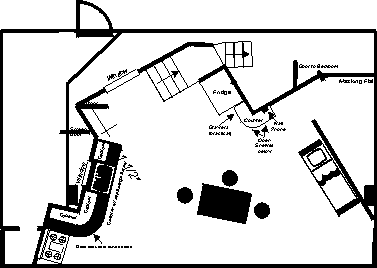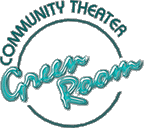|
||||||||||||||||||||||||||||||||||
Step 4: Rough It Out
|
OK, you're inspired, you've talked to the director and the set crew, and you've got some ideas. Now it's time to start getting those ideas on paper. Go over to your theater after the last set has been struck and before the next one (probably yours) is going to go up, so you can work on an empty stage. Take a pad of paper with you. If your construction crew didn't have stage measurements for you, take a partner and a tape measure with you and measure the stage. All stages have their own peculiarities, but at the least you should measure the length of the front of the stage (across the proscenium) and the depth (from the edge of the stage facing the audience to the back wall). Close the curtain and measure the distance from the front edge of the stage to the curtain (if you want to doublecheck, go behind the curtain and also measure from the curtain to the back wall). You may have additional measurements to take; for example, in our theater, we have two large posts that hold up the roof on either side of our stage that I've taken measurements from to get their exact placement, a low ceiling over our stage right wing space that I've measured vertical distance for, a step in front of the stage, and some other oddities. Just take into account as many details as you can to get it as exact a picture as possible. I found it easier to draw a rough plan of the stage on a piece of paper and label each area that I measured on the plan - this was more clear to me than a list reading "back wall - 28 ft.," stage left edge of stage to wing - 6 ft.," etc. Once you've got your measurements, sit out in the house and contemplate the stage. Think about where the best places are for exits and entrances for this show, how wide and tall you can build platforms or stairs if you're using them, and where you can put various set pieces. Visualize what it would look like and how it would all fit together on your stage. Make some rough sketches of possible floor plans while you're sitting there, concentrating on the placement of walls, entrances, built-in elements like bookshelves, kitchen counters, or fireplaces, any platforms you may be thinking about using, and large items of furniture. Don't worry about exact measurements for now - just try out possibilities. Here are some points to keep in mind when deciding where to put walls, entrances and other basic elements: Diagonals are more visually interesting than perpendicular and parallel planes. Try to put walls and furniture on a diagonal if possible, but do it so it makes sense. Pretend that your whole room is not facing the audience, but slightly turned, as in my set design for Crimes of the Heart illustrated below. You'll notice that while most walls are still perpendicular in relation to each other, all the walls are on a diagonal to the audience. This is much more interesting than a flat box-type set with back walls that face the audience head-on (although I've certainly done that as well). Likewise, furniture on a diagonal gives a director greater leeway when blocking. Make sure that you don't place tall items where they will block the action (unless called for in the script). Tall lamps, for example, are notoriously difficult to place on a center stage end-table because they'll block anyone standing behind them. As a director, I once had an actor hang a coat over the back of a chair that was set slightly askew in front of a downstage left desk. I didn't realize until I heard a complaint from a patron after opening night that, once that coat was placed, a third of the front row couldn't see action going on upstage of the desk! (Hey, it was only my second outing as a director - I learned my lesson) 
Openings in the set (such as doors and windows) need to make sense in the real world. If you have an exit to the bathroom downstage on the stage left wall, and an exit to the bedroom upstage on the same wall, don't put a window that looks out onto the street below between them. The audience's perception when an actor exits stage left is that he or she is in the next room, not hanging in space over the street! If the set is an office with a normal door, the door will open inward onto the stage, because that's the way office doors work - the person entering from outside pushes the door open to get inside. Closet doors, on the other hand, usually open outward. You also need to keep in mind where the actors go when they leave the stage - in most houses, the kitchen and dining room are on one side of the living room, and bedrooms and private spaces are in another part of the house. So it might not make too much sense to have an unseen dining room and an unseen bedroom on stage left, and an unseen kitchen on stage right. Fireplaces are often (although not always) on an outside wall. These aren't hard and fast rules, but you do have to think logically both about where people go when they're off stage and how things normally work in the real world, unless you're doing a minimal set or one that needs to break with convention. Differences in vertical height also make for a more interesting set. I've mentioned platforms quite a few times here because I like them for this very reason - they allow me to use different levels. A common place to use a platform sheerly as a decorative element and to add interest is in front of an often-used entrance - just inside the front door, for example, or leading out to a patio. That way when characters make an entrance, they instantly command attention because of their elevated height. A 6- to 8-inch-tall platform is ideal for this kind of unobtrusive height differential - your theater may have a standard size for a one-step platform, so check with your construction crew. Platforms are also great for minimal sets - when our theater produced Dandelion Wine, which consists of a number of short vignettes, the director asked for two wide platforms, one eight inches tall and the other approximately 48 inches tall, with two sets of stairs leading to the taller of the two. Those two platforms were believably used as an upstairs bedroom, a front porch, a basement, a parlor, a garden, and several other locations, and the effect was much more interesting than a bare stage would have been. Just be sure that you have enough space to make your platform wide enough to comfortably accommodate an actor standing on it - you don't want it so narrow that they have to sidle along it for fear of falling off. Stairways, balconies and columns also add vertical interest.  Curves can be very interesting on stage - try an arched window, doorway, or alcove, a spiral staircase, or low steps that curve out instead of being straight across. And talk with your crew to make sure they can be done! NEXT: Step
5: Draw Your Plan |
|
The
Community Theater Green Room www.communitytheater.org © 1999 - 2007 Chris & Mike Polo All rights reserved. |


